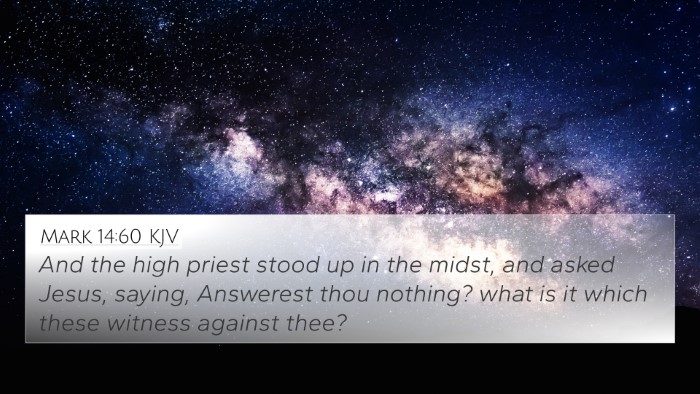Mark 15:3 - Biblical Interpretation and Meaning
Verse Context: Mark 15:3 states, "And the chief priests accused him of many things: but he answered nothing." This poignant moment occurs during the trial of Jesus, highlighting His silence amidst false accusations. Various public domain commentaries offer insights into the significance of this behavior and its broader implications within the narrative of the Gospels.
Insights from Commentaries
-
Matthew Henry:
Henry emphasizes the profound nature of Jesus' silence. He argues that Christ's unwillingness to defend Himself against baseless charges exemplifies the fulfillment of Isaiah 53:7, which foretells the suffering servant who, like a lamb led to slaughter, opens not His mouth. This silence is portrayed as a demonstration of strength and a refusal to engage in futile arguments. Moreover, it signifies Jesus' submission to God's will as He prepares for the ultimate sacrifice.
-
Albert Barnes:
Barnes provides a detailed analysis of the trial proceedings against Jesus. He notes that the chief priests and leading figures presented multiple accusations without substantial evidence. This tactic illuminates the corrupt nature of the trial, illustrating how those in power often manipulate judicial proceedings. Barnes posits that Jesus' silence serves as a powerful rebuttal to the falseness of the charges, showcasing His composure and divine authority amid chaos.
-
Adam Clarke:
Clarke stresses the significance of the chief priests’ accusations. He highlights that their aim was not merely to judge Jesus legally, but to destroy Him morally and spiritually. Clarke points to the prophetic nature of Jesus' silence, explaining that it demonstrates a spiritual readiness to bear the weight of humanity's sins. Clarke's interpretation encourages readers to reflect on their own responses to false accusations and the importance of maintaining integrity in challenging circumstances.
Thematic Connections
Mark 15:3 serves as a critical pivot in the Passion narrative, encapsulating themes such as injustice, divine sovereignty, and submission to God's will. Below are metaphorical connections and cross-references that deepen understanding of this verse:
- Isaiah 53:7: "He was oppressed and He was afflicted, yet He opened not His mouth..." - This prophecy directly relates to Jesus' silence during His trial.
- Matthew 26:63: "But Jesus held His peace..." - Reflects Jesus' silence before the high priest during an earlier trial.
- John 19:9: "And went again into the judgment hall, and saith unto Jesus, Whence art thou? But Jesus gave him no answer." - John's account corroborates the theme of silence against accusations.
- 1 Peter 2:23: "Who, when he was reviled, reviled not again; when he suffered, he threatened not..." - This verse connects to Jesus' example of enduring suffering without retaliation.
- Proverbs 18:13: "He that answereth a matter before he heareth it, it is folly and shame unto him." - This proverb can reflect the unjust process against Jesus.
- Hebrews 12:2: "Looking unto Jesus the author and finisher of our faith; who for the joy that was set before him endured the cross..." - Highlights Jesus' focus on His mission despite the injustice he faced.
- Luke 23:9: "Then he questioned with him in many words; but he answered him nothing." - Another parallel of Jesus' silence during trials.
Conclusion and Reflection
This analysis of Mark 15:3 through the lens of various commentaries reveals rich layers of meaning, showing how Jesus' silence conveys profound theological truths about His mission, character, and the fulfillment of prophecy. The connections between this verse and others throughout the Bible illustrate the cohesive narrative of Scripture regarding Jesus' life and purpose.
Studying cross-references between Bible verses like Mark 15:3 enriches one’s understanding of the biblical text and provides essential insights into the interconnectedness of Scriptural themes. Utilize tools for Bible cross-referencing, such as a Bible concordance or a Bible cross-reference guide, to explore these connections further and understand how Biblical texts dialogue with one another.










